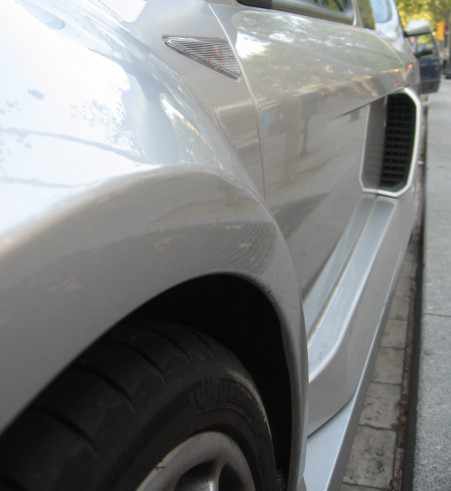For Canadians, the Renaultsport brand-within-a-brand may be unfamiliar, which is just fine because Renault doesn’t currently sell its wares on this continent. Perhaps the first time you heard the name “Renaultsport” was when Top Gear Magazine made the motorsports division their Manufacturer of the Year for 2009. Or maybe you missed that too.
Even those of you who are already familiar with their current Twingo 133, Clio 200, and Megane 250 offerings, may not be acquainted with the storied brand’s previous models – all of which were the result of the accumulated artistry, engineering adroitness, and experience of the very best minds within the French company. I happened upon one such result this summer in Barcelona, Spain.
While Renault Sport has a storied history of producing successful racing cars (as exemplified above by the 24 Hours of Le Mans-winning Alpine A442B), it was not until the year 1999 that the Renaultsport division would see its name emblazoned on a road car. That car was the Clio Renaultsport 172. While not the division’s first foray into tuning road cars (lest we forget the Clio 16V and the Clio Williams), it was the first to bear the badge. And it was an absolute corker. This is despite what we, on this side of the Atlantic, might consider to be a lacklustre 172hp. With a 0-60mph of just 7 seconds, just as fast as the original E30 M3, the little hot hatch was plenty quick. It also set the stage for further Renaultsport products, each boasting slightly more horsepower, slightly better refinement, and even better value for money. Really, Renaultsports are not about outright power – a foreign concept for Canadians, both literally and figuratively. Instead, Renaultsport road cars are highly regarded for their millimetre-precise steering, the near-miraculous feat of chassis engineering that combines body control and suppleness, and their rather low cost.
As a follow-up to the Clio 172, the Second Act to the opera that is Renaultsport saw the introduction of the Clio 182. A car that offered a slight bump in horsepower over the 172, while maintaining all of the quaint, loveable insanity of the original – as Jeremy Clarkson demonstrates…
After that gem came a car so blindingly mental and brave that it will maintain a bookmark in Renault’s historical catacombs for, well, ever. Also, as I mentioned earlier, I stumbled upon an example of Renaultsport craftsmanship in Barcelona this past summer. Well, these two cars are really one and the same: the Clio Renaultsport V6. A rear-seatless, rear-wheel driven, mid-engined tribute to Renault’s Formula 1 efforts.
If only that double-decker tourist bus hadn’t jumped into my shot like a Japanese tourist with her two-fingered gang sign, you could have had Barcelona’s Plaça de Catalunya as a backdrop. Oh well. Launched in late 2000, the Clio V6, unlike the pedestrian front-engine, front-wheel drive car on which it is based, was known for its unwieldily on-limit handling due in part to a weight increase of 660lbs over the stock Clio. Most of said weight was over the rear, leading to to handing that wouldn’t be out of place in an early 911 Porsche. The Phase I car, built by Tom Walkinshaw Racing, featured the 2946cc 24V 230hp engine from the Renault Laguna mounted behind the front seats. In 2003, when the Clio recieved a mild face-lift, (now Phase II) production was taken over by Renaultsport in Dieppe, the same port where thousands of our Canadian soldiers valiantly fought and gave their lives on August 19, 1942.
Barcelona was our first stop in Europe and Plaça de Catalunya was our first stop off the bus from the airport. As I gazed around the Spanish port to establish my bearings in the new city, my eyes stopped dead on a compact silver beast with side-nostrils flaring. I dropped my bags and jogged across the street, noticeably forgetting to look either way for traffic. My 10-minute-old vacation was nearly ended when an Alfa Romeo Brera came barrelling through in typical European pedestrian-disrespecting fashion. No matter, because before me lay the most special car my eyes had ever laid eyes upon. I was already familiar with the Clio V6, at least in principle, so I knew what my eyes were seeing. And yet, I didn’t – it was as if the action potential from my rods and cones was being lost at the optic chiasm, destined to never reach my lateral geniculate nuclei.
After production of the Clio V6 ended in November of 2005, Renaultsport went back to making more sane, but still very good, hot hatches. No more rear-wheel drive. No more engine behind the driver. Only slightly less Gallic flair. It wouldn’t be until 2008 when Renaultsport unleashed the Megane R26.R on an unsuspecting hot hatch community, that we would again be reminded of the motorsport division’s potential. The R26.R was the swan song for the previous generation of Megane, itself not a particularly special car. But when dressed up for the races with a full roll cage, 6-point racing harness, cut-slick Toyos, carbon fibre hood, and a titanium exhaust, the R26.R lapped the Nordschleife faster than any other front-wheel drive car had ever done before. Or since.
When compared to the likes of the Clio V6 and the Megane R26.R, Renaultsport’s current line-up is admittedly tame. But just wait, because something special is on its way. I just know it.
Image credits: author, Canal Blog, author, author, author, steven_bullock_uk/flikr







